Tips for Food & Drink
 Some food packaging and storage methods are known sources of chemicals of concern, including hormone disruptors. Other sources of chemicals are less well-studied or described. However, simple changes can help you limit your exposure to hazardous chemicals in food and drinks.
Some food packaging and storage methods are known sources of chemicals of concern, including hormone disruptors. Other sources of chemicals are less well-studied or described. However, simple changes can help you limit your exposure to hazardous chemicals in food and drinks.
Top 10 tips
1. To avoid pollutants like PCBs that accumulate in fat, remove the fat and skin from meat and fish before cooking. Drain fat that accumulates while cooking.
2. Choose smaller, younger seafood over larger older seafood.
3. Avoid eating canned food or moist food packaged in plastic or lined cardboard.
4. Choose organic produce, meat, and dairy when possible.
5. Microwave and store foods in glass rather than plastic.
6. Switch to a glass or stainless steel French press or drip coffee maker.
7. Phase out non-stick pans from your kitchen.
8. Use glass or stainless steel water bottles instead of plastic.
9. Don't drink out of a water cooler supplied by plastic jugs.
10. Use solid block or granulated carbon filters to purify drinking water.